
Home - AFV Events - Other AFV Events - Petersen Automotive Museum
The Petersen Automotive Museum is one of the premier automobile museums in the world; I was lucky to have it in Los Angeles during most of the time I lived there. In 2006 there was a special exhibition on the topic of "Alternative Power: Propulsion After Petroleum," and I took my young family there to see it. Our kids were four months old and three years old, and right about then is when I simply got too busy to put new content on this website, so that it went on an almost nine-year hiatus (note big gap in entries on the What's New page) and I never posted the photos from that visit. However, when the museum reopened in December 2015 after an extensive renovation, I returned on my next visit to Los Angeles (we had also moved to Hawaii during that website hiatus) in February, and went again in June. I present here some photos from the 2006 special exhibit, and also from my recent visits to the permanent exhibit on the topic that's there now.

Greeting you near the entrance at the 2006 special exhibition was this Honda FCX fuel-cell vehicle (FCV), which I had first seen at the 2002 Los Angeles Auto Show, along with a cutaway chassis, in front of an appropriate pop-art backdrop. This one is in the livery of the Los Angeles Department of Water & Power, as I saw at the 2003 LA Auto Show.

Fuel-cell vehicles also had pride of place at the entrance to the exhibition upstairs. This is the GM Autonomy concept vehicle; as I had seen at the 2003 Anaheim Auto Show, the "skateboard" at right contains the drivetrain and control electronics, allowing a variety of bodies like the one at left to be built atop it.

Reaching back in time, the vehicles on display upstairs included the 1966 GM Electrovan, the first FCV ever built. Most of the interior is filled with the fuel-cell system, which included tanks for liquid oxygen and liquid hydrogen for power and potassium hydroxide solution for an electrolyte. This is a far cry from the more recent FCVs on display (that's the corner of a Ford Focus FCV in the foreground), which use gaseous hydrogen, oxygen from the air, and plain water in the fuel cell stack!
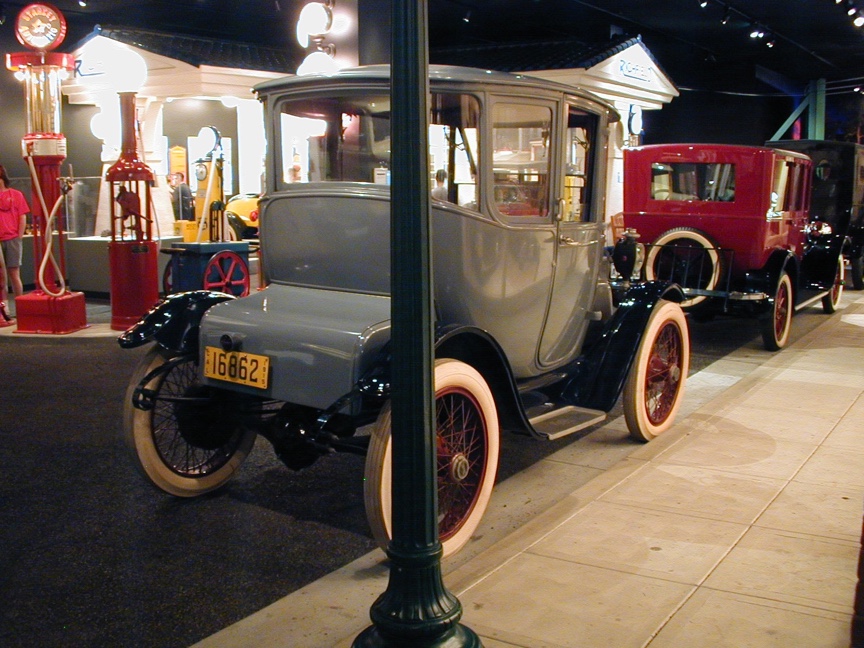
Alternative-fueled vehicles (AFVs) go back quite a bit farther than these; in the first twenty years or so of the 20th century, until the electric starter made gasoline vehicles much easier to use than during the days of hand-cranking, there were about equal numbers of electric, gasoline, and steam cars on the roads of the U.S. This is a 1915 Detroit Electric, parked in a street diorama downstairs with other vehicles of that vintage.

At the other end of the age range, this just-introduced Tesla Roadster was parked in front of a diorama of a Southern California Speed Shop. This was the first time I had seen a Tesla up close! In the renovation at the end of 2015, they opened up a lot more space for rotating exhibits, but as part of that they took down all of these dioramas on the ground floor; I'll miss them.
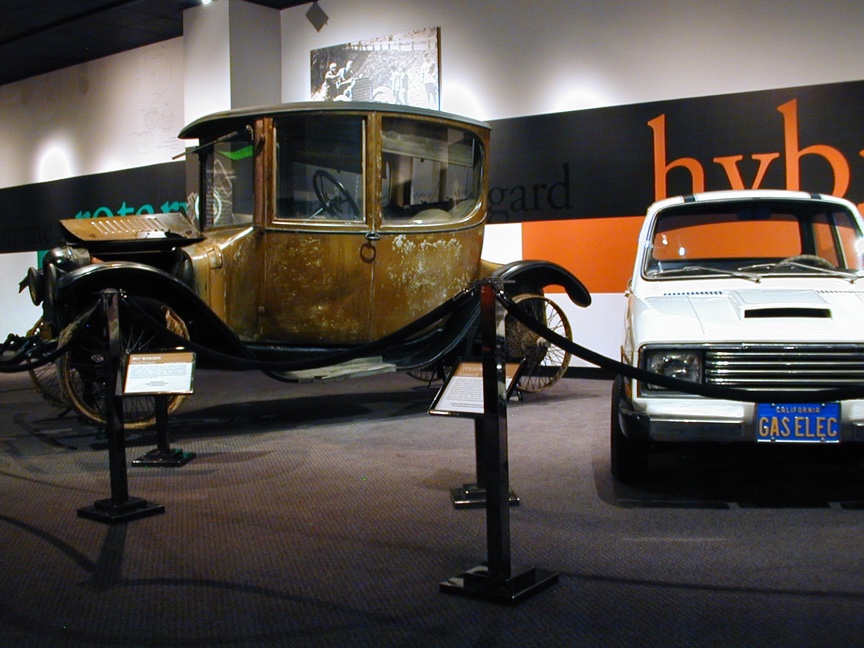
Back upstairs, there were a large variety of vehicles spanning the length of the 20th century and into the 21st, and running on everything from steam to vegetable oil. Here are two hybrids separated by six decades, a 1917 Woods Dual Power and a 1978 Hybricon Centaur II, which was a conversion of a Honda 600.
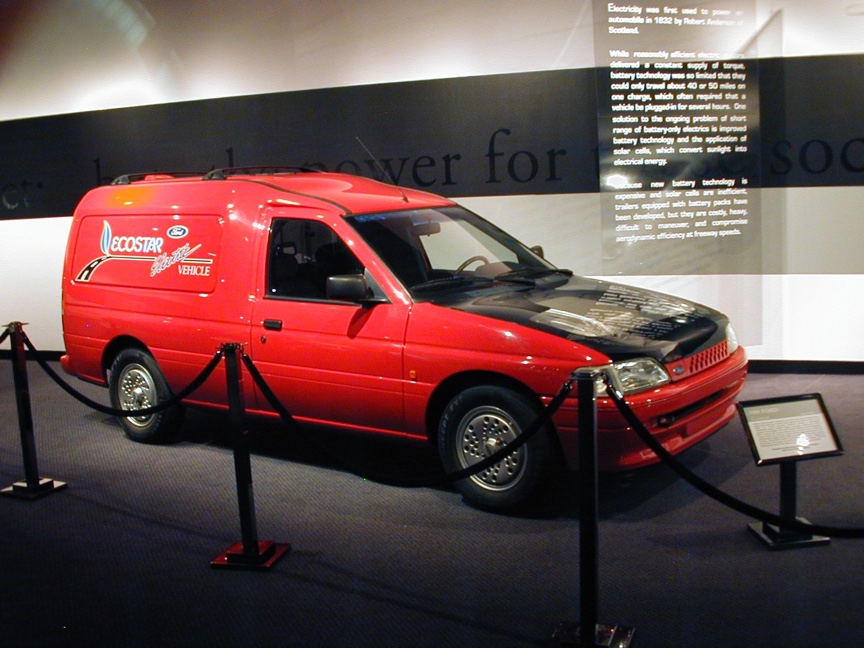
This is a rarity, a Ford Ecostar electric vehicle from the early 1990s with a sodium-sulfur battery. This was an early attempt to develop a better battery technology for this purpose than lead-acid (more capacity, less weight), but such batteries had to be maintained at temperatures of hundreds of degrees or they would freeze, which ultimately caused them to be set aside as impractical. Advanced battery technology proceeded through nickel metal hydride (NiMH) batteries to the lithium-ion batteries that are pretty much universal in today's battery-only vehicles, like the Tesla Roadster above (many hybrids still use NiMH).
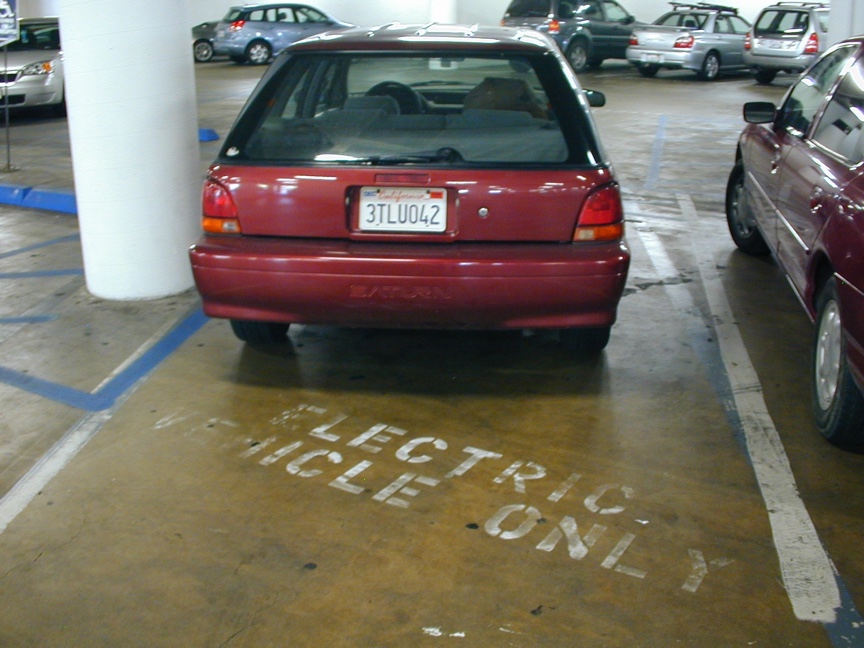
Several years before the modern renaissance of plug-in vehicles, 2006 was a dark time for EVs. The generation that included the Ecostar had been dropped from production and, as much as possible, dropped down the Memory Hole by automakers. A few RAV4-EVs and a very few Chevrolet S-10 and Ford Ranger electric pickups escaped the crusher because they had been sold, not merely leased; a few GM EV1s and Honda EV Pluses were donated to museums (the Petersen had their two on display at this exhibition). Public recharging infrastructure that had been built began to disappear, like the chargers that used to be next to these former EV parking spaces in the Petersen parking garage.

However, 2006 was also the year that the documentary Who Killed the Electric Car? came out, which I, at least, think deserves significant credit for keeping pressure on automakers and regulators not to stonewall the increasing need for "Propulsion After Petroleum." As I noted above, it was also the year that Tesla introduced their first vehicle. Fast forward a decade, and automakers are building more and more, and better and better, plug-in vehicles, with Tesla well established among their ranks; and public recharging stations are starting to proliferate again to serve these vehicles, as at these new parking spaces at the Petersen. (I closed the museum that day, so there probably would have been vehicles using those chargers earlier.)
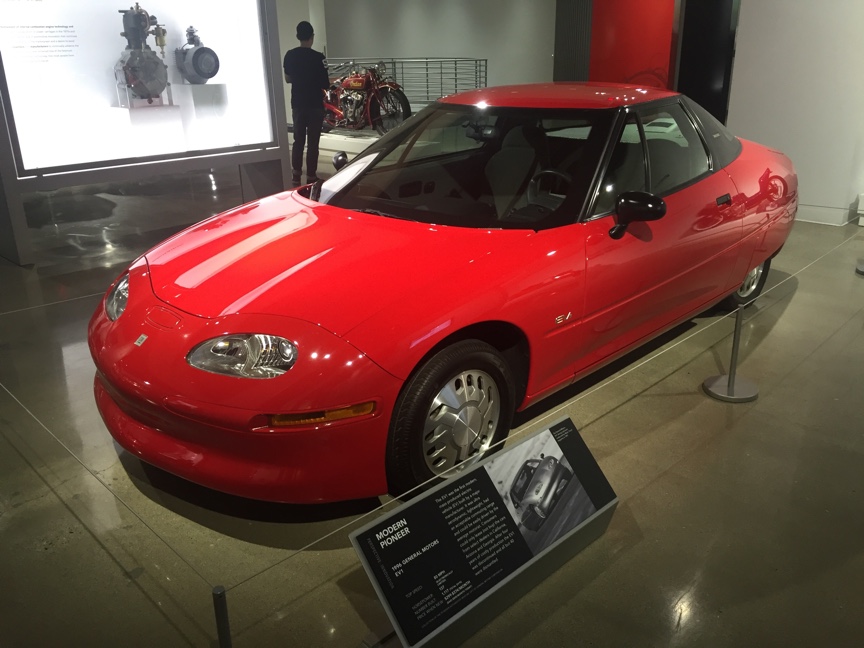
Today, the Petersen has a permanent display on alternative fuels and vehicles, in an area that's smaller than the special exhibition of a decade ago but still a very impressive commitment of their floor space. The vehicles on exhibit rotate; the Electrovan and Detroit Electric were there when I visited, for example, but the EV Plus and Ecostar were not. The EV1 was also not in the AFV display, but that's because it had a place of honor on the top floor in the area on the history of the automobile, with a sign describing it as a "Modern Pioneer." Entirely fitting, I thought! The Petersen collection's EV1 is Number 99, the car driven by Kris Trexler on his Charge Across America and featured (in the museum's vault at the time) in "Who Killed the Electric Car?"

I donated my 1993 Dodge van, powered by compressed natural gas (CNG), to the Petersen when my family moved to Hawaii at the end of 2007; I don't know if she has ever been displayed, as such a vehicle is not visibly (i.e., interestingly) different from any other gasoline van except under the body. Natural-gas vehicles (NGVs) were represented in the exhibit when I visited by this 1939 Fiat 508C Balilla; this was the very first NGV on record, converted by Alejandro Tartarini in response to fuel shortages before WWII. There was a 1938 Citroën 11 in the 2006 exhibition that had been converted to run on coal gas for the same reason.

There was a hybrid on display that was even older than the 1917 Woods shown above, a 1914 Galt made in Canada and on loan from the Canadian Automotive Museum in Ontario. There was also this 2012 Fisker Karma, a luxury performance hybrid that was introduced at the 2009 Los Angeles Auto Show. Nearly a century of progress! The Fisker was shown in front of what I think is another permanent display about automotive design at the ArtCenter College of Design in Pasadena; Henrik Fisker, who founded the company, is an alumnus.
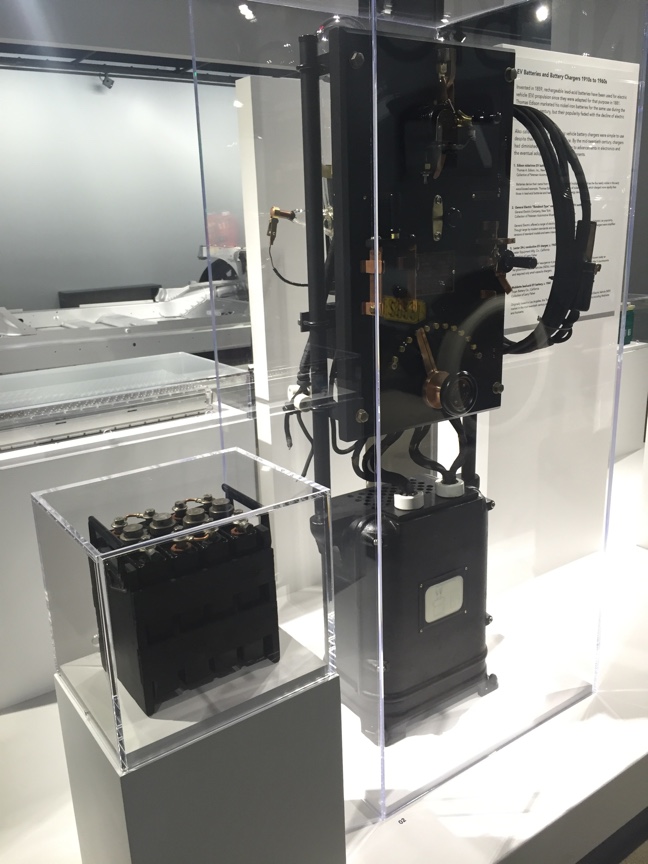
The current AFV display includes a lot of information about the fuels and infrastructure as well as the vehicles. Next to a modern battery pack and charger, and a pair from the 1960s, are this Edison nickel-iron battery and GE charger (at the time called a "rectifier") from about 1915. There was also a collection of refueling nozzles for various liquid and gaseous fuels, plus electricity, that puts the display on the front page of this website to shame!

In the decade between my visits, fuel-cell vehicles also made the jump from prototype to production. Here are a 2008 Honda FCX Clarity, which exited experimental status (the "X" in "FCX") as the 2017 Clarity, and a 2016 Toyota Mirai, which became available for outright sale, not merely for lease, in late 2015. That's the chassis of a Tesla Model S sedan behind and between them, with the Galt hybrid, Detroit Electric, Electrovan, and CNG Fiat lined up on the left wall. The colorful segmented circular diagram on the far wall collects a wealth of information about fourteen different fuel types, conventional and alternative, centuries-old and modern.
All in all, the Petersen Automotive Museum has done an outstanding job of educating the public about alternative fuels over the years. I am honored to have been allowed to make a small contribution to the collection, even if she never comes out of the vault (I have also donated some documents and memorabilia on alternative fuels that I've collected over the years, and have much more to follow when I can catalog and scan them to post on this website). I look forward to visiting many more times over the years, as I continue to return to Los Angeles!
 Back
to AFV Events Page
Back
to AFV Events Page Back
to Fueling Station
Back
to Fueling Station Site
Map
Site
Map Contact
Me
Contact
Me All content copyright 1998-2024 by Mark Looper, except as noted. Reuse of my copyrighted material is authorized under Creative Commons Attribution 4.0 International license (CC BY 4.0).
![]()
![]()
new 3 December 2016